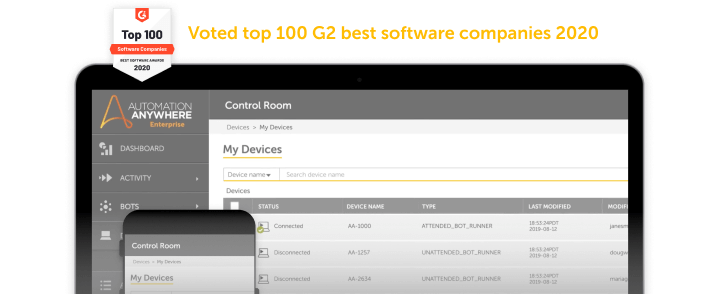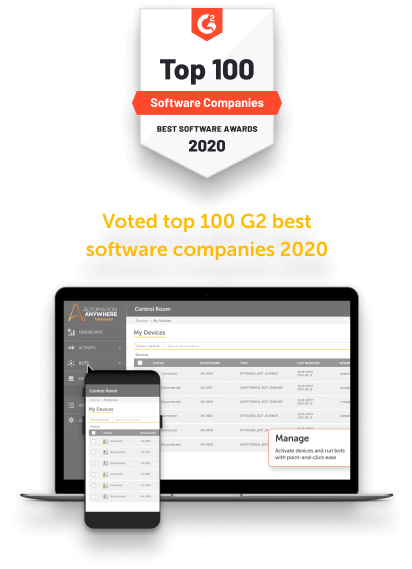- Login
- Search
- Contact Us
-
Have a question? Our team is here to help guide you on your automation journey.
-
Explore support plans designed to match your business requirements.
-
How can we help you?
-
- /AI
AI Without the Hype From pilot to full deployment, our experts partner with you to ensure real, repeatable results. Get Started
- Automation Anywhere AI
-
- Products
Platform Features
- Agentic process automation (APA)
- Robotic Process Automation (RPA)
- View all Products
-
- Solutions
Featured Agentic Solutions
Accounts Payable Invoice automation—No setup. No code. Just results. Accounts Payable
Customer Onboarding Scale KYC/AML workflows. Customer Onboarding
Customer Support Keep queues moving, even at peak load. Customer Support
Healthcare RCM Revenue cycle management that runs itself. Healthcare RCM
- Resources
Get Community Edition: Start automating instantly with FREE access to full-featured automation with Cloud Community Edition.
Featured
 Named a 2025 Gartner® Magic Quadrant™ Leader for RPA.Recognized as a Leader for the Seventh Year in a Row Download report Download report
Named a 2025 Gartner® Magic Quadrant™ Leader for RPA.Recognized as a Leader for the Seventh Year in a Row Download report Download report- Become an Expert
- Developer Tools
- Get Support
- View all resources
-
- Partners
Find an Automation Anywhere Partner Explore our global network of trusted partners to support your Automation journey Find a Partner Find a Partner
- Find a Partner
- For Partners
-
What is Workflow Automation?
Workflow automation is an easy way to sequence and complete all the tasks in any work process without manual effort.
Workflow Automation uses common forms of automation like Robotic Process Automation (RPA) and Business Process Automation to move the right information between IT system components according to defined business rules to perform steps for onboarding new employees, for example.
Workflow automation is the key to making digital processes for any job function (HR, accounting, procurement, etc.) flow in a repeatable series of steps without human intervention. Users simply define those steps and identify what must be done in them to automate workflows with self-service methods like drag-and-drop or modeling what should happen. The resulting automation makes these processes more consistent, accurate, and efficient—at enterprise scale.
What are the Benefits of Workflow Automation?
Workflow automation lets you capitalize on digital transformation by empowering users to complete more workflows quicker, easier, and better than they can manually or with paper. The self-service nature of workflow automation software provides these advantages to all employees, not just the tech-savvy ones.
These tools enable each business unit to boost its productivity so companies can get more work done and fulfill core mission objectives. With workflow automation, businesses maximize the use of their employees by accelerating what would otherwise be manual processes, which are typically slow, inconsistent, and prone to error. Workflow automation tools remove these bottlenecks. Specific benefits include:
Accuracy
The accuracy of vital department functions—like ensuring invoices are paid the right amount—can’t help but increase with workflow automation software since, unlike with human employees, these automated tools always do what they’ve been trained to do. This approach eliminates human error.
Lowers Costs
Workflow automation is essential to enabling organizations to do more with less. Improving the efficiency and productivity of humans drastically lowers costs associated with errors and reduces the number of workers required to complete specific workflows.
Transparency
Workflow automation software is critical for increasing visibility into the most complicated processes. It ensures they’re mapped out, repeatable, and sustainable for flawless accountability into which workers or factors are responsible for specific business outcomes—which can otherwise be a costly, time-consuming ordeal to investigate.
Job Satisfaction
The higher levels of productivity and efficiency workflow automation supports don’t just impact the bottom line. This improved effectiveness also translates to greater job satisfaction for individual workers, leading to increased retention rates and better talent acquisition.
Workflow Flexibility
Users can map out, fulfill, and coordinate the completion of any number of tasks in a workflow, no matter how difficult they are. Subsequently, they can automate complex processes involving unstructured and structured data to account for any enterprise workflow needs.
Scalability
Scale is likely one of the chief benefits of workflow automation software. It empowers users to perform the discreet tasks for any process regardless of how much data or people it involves—like implementing security credentials for workers from a recent merger. Automating these workflows ensures these processes occur as smoothly as they would at a much lower scale.
Who is Using Workflow Automation?
Workflow automation is horizontally applicable across verticals and business units. You’d be hard pressed to find any industry or department not using some form of this type of automation in some way. Since its core advantages of increased efficiency, effectiveness, scale, and cost reductions are universally desirable in any work setting, workflow automation is usually found in most of them, regardless of these points of distinction.
Still, the departmental use cases for workflow automation are usually greater in some business units than in others. Human resources is a prime candidate for workflow automation largely because of the inordinate reliance on paper this domain traditionally had. The same sentiment applies to accounting. Customer support teams are also frequent workflow automation software users because it enables them to swiftly access any number of systems to resolve issues to satisfy customers.
Financial services and banking likely has the greatest adoption rates of workflow automation tools because of their support for knowledge workers. Other verticals include insurance, sales and marketing, and healthcare. Specific use cases include:
Human Resources
There are a number of valuable functions workflow automation streamlines and accelerates in HR. In addition to onboarding and offboarding employees, these tools are effective for managing vacation requests, timesheets, and the various steps required to process benefits. They’re useful for expediting any changes related to HR, like those for health insurance plans.
Legal
Workflow automation is instrumental for automating core functions in individual legal departments or for companies in the legal space. Methods like RPA excel at extracting information from client intake forms and positioning them in downstream IT systems. Users can also automate workflows to keep track of case deadlines, contract reviews, and legal holds.
IT Teams
There is a plethora of uses for workflow automation in IT. The most pressing is likely for processing service requests, which otherwise isn’t always straightforward. This approach is also useful for processing and dealing with security incidents and for setting up new accounts. Additionally, workflow automation tools accelerate ad-hoc service access requests for auditing and data governance purposes.
Accounting
There are several accounting workflows you can automate to increase effectiveness. Most things related to approvals or requests (like CapEx or AFE requests, or expense approvals) can be automated to reduce time to action. Similarly, items pertaining to accounts payable, accounts receivable, or making changes to salaries are ideal for workflow automation solutions.
Healthcare
Workflow automation improves some of the most vital processes in healthcare. In addition to processing claims forms for diagnostic and medical procedures, it’s also influential for automating various aspects of billing. Operational advantages include processing on-call rotations and work schedules for staff. Additional examples include processing patient admission and discharge forms.
Financial Services/Insurance
Some of the core processes in finance and insurance are routinely handled with workflow automation capabilities. Claims processing for mortgages and loans—including aspects of the approval process—are some of the most important. Others include identifying and ingesting information to make decisions for financial analysts and investors.
How Do I Get Started with Workflow Automation?
Users can get going with Workflow automation by following a five-step plan based on determining which processes benefit from automation, outlining business goals of automation, selecting automation software, training team members on it, and refining workflows with KPIs to expand ROI.
STEP 1
There are several ways to identify processes that are beneficial to automate. These can range from the obvious (seeing which processes regularly have to be redone, which have the greatest impact on cost, or which are most detrimental to employee efficiency) to the more scientific, in which you visually represent tasks in processes with flow diagrams. A combination of both of these approaches typically works best. Workflows that are more complicated than others, are mission critical, or highly repetitive are prime for automation.
STEP 2
Next, it’s critical to outline business goals related to the process. These should be well defined and a natural output of the process—ideally minimizing variation. It helps to think of these goals in “either/or” terms. For example, an applicant is either approved or denied for a loan. Implicit to this step is specifying which tasks in the workflow contribute to the business goal in mind, and how. Although processes maybe multifaceted, the tasks in them and their relation to the business goals should be simple.
STEP 3
There are a couple considerations influencing which workflow automation software you should select. These hinge on the specific use case, the industry, and the department. For tasks involving decision-making or analytics, RPA—which is frequently paired with Artificial Intelligence and machine learning—is useful. During this step you should think
STEP 4
Training users in the workflow automation tool is foundational to succeeding with it. Options like RPA have extremely low learning curves and don’t require much training. Typically, organizations simply demonstrate the process they’d like this software to perform on screen, which it then internalizes and automates.
STEP 5
The final step is refining the workflow based on results in production. KPIs can determine how successful workflow automation software is. For instance, users can have an accuracy threshold (above 90 percent for retrieving information required to satisfy a specific customer service request, for example) that serves as the basis of approval of an automated workflow. Continuous monitoring and assessment of KPIs will indicate how much of a workflow should be changed, and when, to achieve business goals from automating processes.
Frequently Asked Questions about Workflow Automation
Workflow automation is the design, execution, and automation of business processes, where tasks, information, or documents are passed from one participant to another according to a set of procedural rules.
Workflow automation improves efficiency, reduces the chance of errors, eliminates unnecessary tasks, and helps to ensure processes are completed in a standardized way. It can also increase transparency and make it easier to track progress.
Tasks that are repetitive, predictable, and rule-based are excellent candidates for workflow automation. This can include things like invoice processing, employee onboarding, customer support tickets, and more.
Workflow automation can be accomplished with a variety of tools ranging from simple task automation software to more advanced platforms that use artificial intelligence and machine learning.
The level of difficulty can vary depending on the complexity of the workflow being automated. However, with the right tools and guidance, most businesses can successfully implement workflow automation to improve efficiency and productivity.



For Students & Developers
Start automating instantly with FREE access to full-featured automation with Cloud Community Edition.
